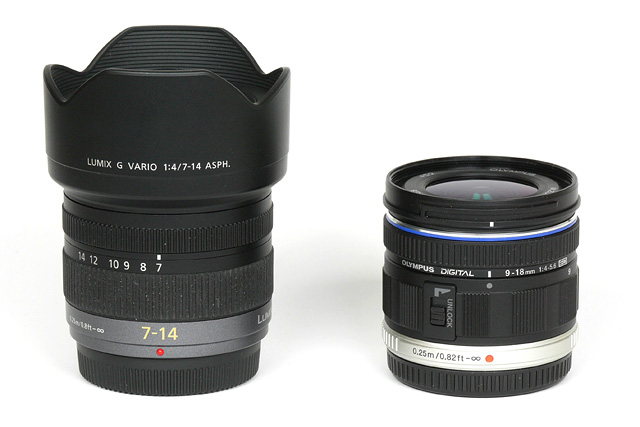|
Olympus M.Zuiko Digital 9-18mm f/4-5.6 ED - Review / Test Report |
|
Lens Reviews -
(Micro-)Four-Thirds
|
|
Page 1 of 3

Review by Klaus Schroiff, published June 2010
Introduction
The Olympus Digital M.Zuiko 9-18mm f/4-5.6 ED is the second ultra-wide angle lens for the micro four-thirds system. Its obvious opponent, the Panasonic Lumix G 7-14mm f/4 ASPH, is surely a more interesting lens on paper but at around 1100EUR/US$ it is far out-of-reach for most users. The new Olympus lens sells for a little more than half the costs and its sheer specs are for sure interesting enough. It offers a field-of-view equivalent to 18-36mm on full format (35mm) cameras so its wide setting is already pretty extreme. However, one of the most amazing aspects of the Olympus lens is its extremely small size and ultra-light weight. This is where you can immediately experience the idea and value-add of a small format system. According to Olympus it is 50% smaller in volume and 40% more light-weight than its classic four-thirds counterpart and that one is no brick either.

The build quality is pretty good for a retractable lens. In its transport position the lens feels tight and solid thanks to high quality plastics. You've to move the lens to its working position prior to being able to taking pictures - this is as easy as simply zooming from the transport position to the 9mm setting. If you want to retract back it into its transport position you've to unlock the zoom mechanism at the 9mm (via a switch) and zoom back again. This may sound complicated and cumbersome but in the real life it's actually a non-issue. The M.Zuiko 14-42mm uses a similar mechanism and we were less than thrilled regarding its build quality in working position but its 9-18mm stable mate is more convincing here. The inner lens tube shows only a very marginal wobbling. Subjectively it lacks "substance" due to the low weight but objectively we can't really find any obvious downsides.
 The small focus ring is coupled to a focus-by-wire mechanism which is commonly used in four-thirds lenses. This may sound like a worrisome approach but it works really well because the camera switches to a high-magnification view as soon as you turn the focus ring and from here on it's more precise than manual focusing on a conventional DSLR setup. The Olympus lens features a AF micro-motor which operates both very fast and silent. The AF accuracy is very high but that's typical for all contrast-detection-based AF systems.
It's naturally interesting to compare the Olympus M.Zuiko to the Panasonic Lumix lens in terms of size. The Panasonic lens is already very compact but it should also be fairly obvious (below) that the Olympus lens is still much smaller in its transport position whereas the size advantage is much less obvious in working mode. However, the Panasonic lens has a fixed lens hood so it remains the bigger package in any case.
The small focus ring is coupled to a focus-by-wire mechanism which is commonly used in four-thirds lenses. This may sound like a worrisome approach but it works really well because the camera switches to a high-magnification view as soon as you turn the focus ring and from here on it's more precise than manual focusing on a conventional DSLR setup. The Olympus lens features a AF micro-motor which operates both very fast and silent. The AF accuracy is very high but that's typical for all contrast-detection-based AF systems.
It's naturally interesting to compare the Olympus M.Zuiko to the Panasonic Lumix lens in terms of size. The Panasonic lens is already very compact but it should also be fairly obvious (below) that the Olympus lens is still much smaller in its transport position whereas the size advantage is much less obvious in working mode. However, the Panasonic lens has a fixed lens hood so it remains the bigger package in any case.

| Specifications |
|---|
| Equiv. focal length | 18-36 mm (full format equivalent) |
| Equiv. aperture | f/8-f/11 (full format equivalent, in terms of depth-of-field) |
| Optical construction | 12 elements in 8 groups inc. 3x aspherical and 1x ED elements |
| Number of aperture blades | 7 (rounded) |
| min. focus distance | 0.25 m (max. magnification ratio 1:10) |
| Dimensions | 57 x 50 mm |
| Weight | 155 g |
| Filter size | 52 mm (non-rotating) |
| Hood | square-shaped, bayonet-mount, optional |
| Other features | - |
|